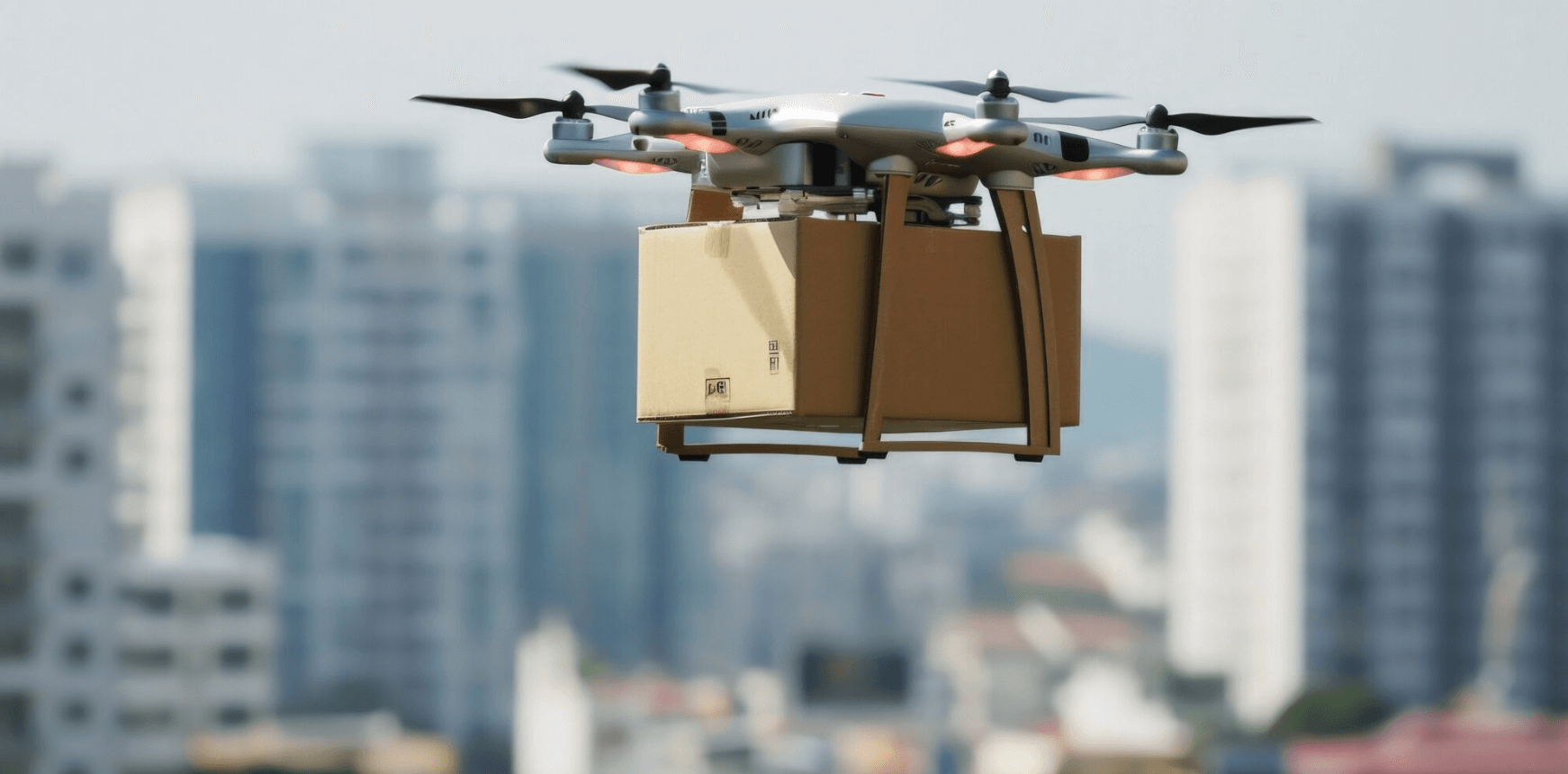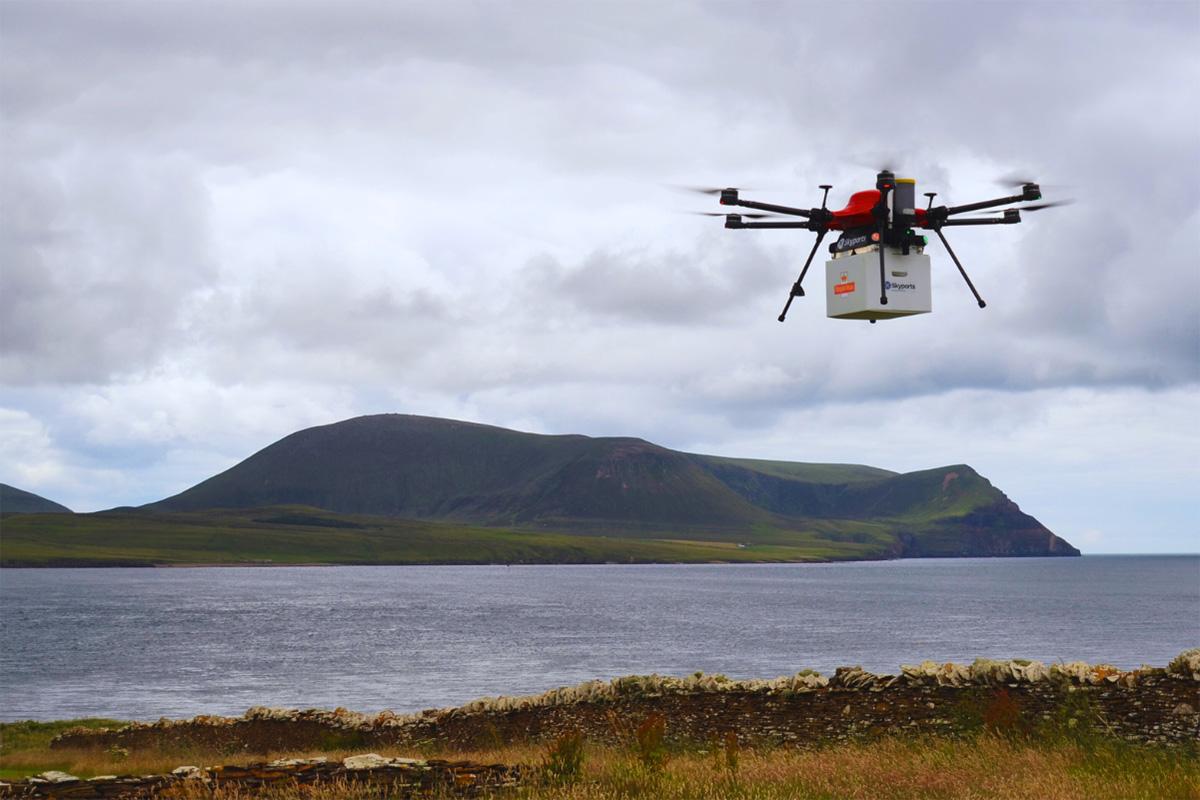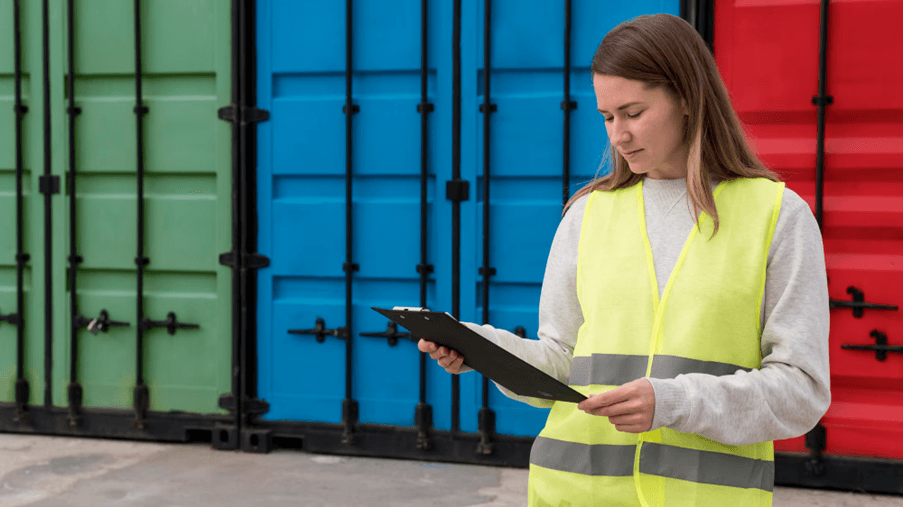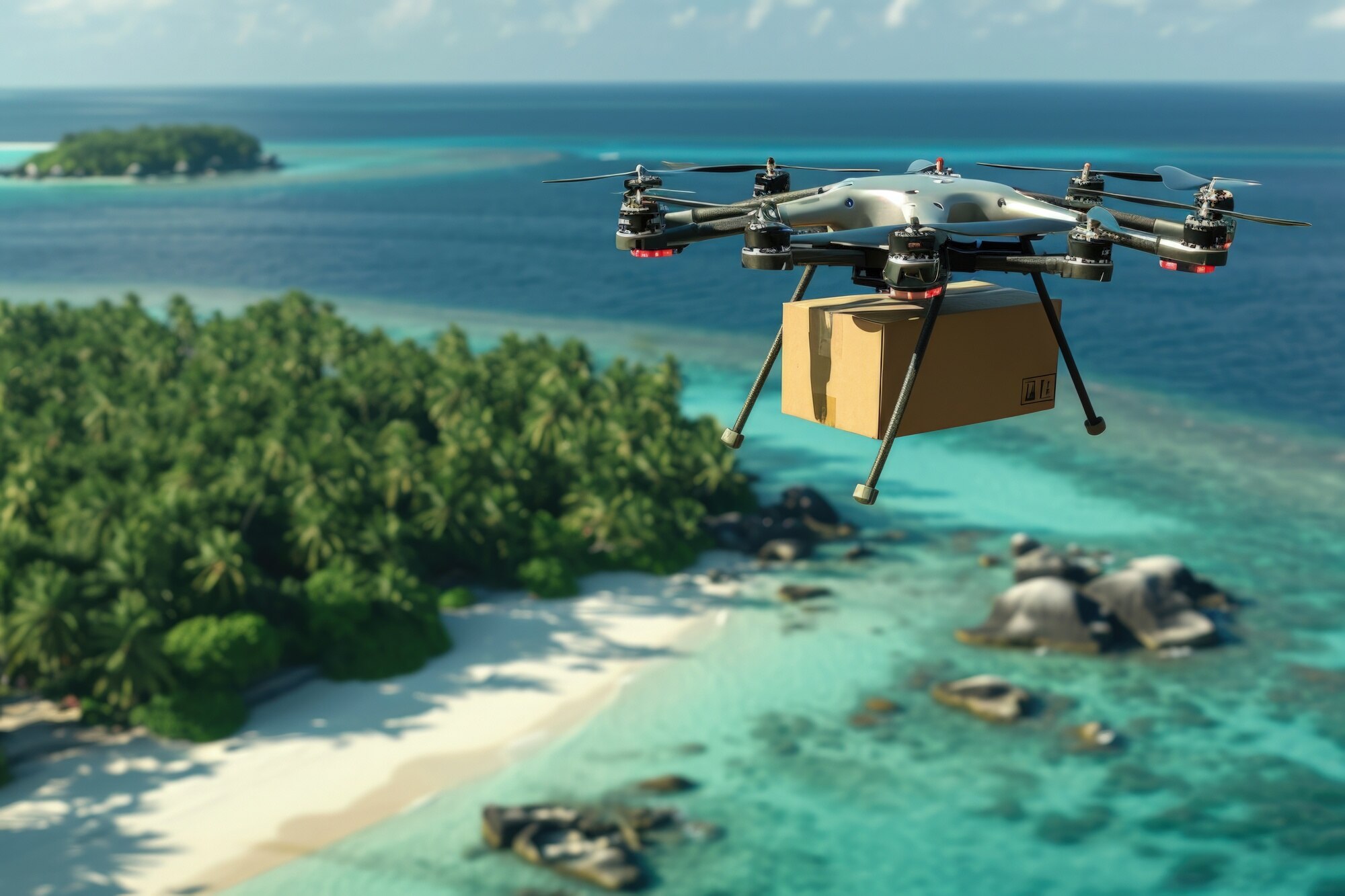The Rise of Drone Robot Delivery
What’s Next for the UK Logistics Industry
The UK logistics industry is on the cusp of a revolution. The catalyst? Drone robot delivery.
This technology promises to redefine the concept of same-day delivery. It’s a solution that could increase efficiency and reduce carbon emissions.

However, the path to widespread adoption is not without hurdles. Regulatory challenges, safety concerns, and public perception are just a few of the issues to navigate.
This article delves into the current state and future prospects of drone delivery in the UK. We’ll explore the role of AI and robotics, discuss the regulatory landscape, and consider the implications for courier services.
Join us as we take a closer look at what’s next for the UK logistics industry in the era of drone delivery.
The Current State of Drone Delivery in the UK
Drone delivery is gaining traction in the UK, with logistical improvements that captivate public interest. Companies are experimenting with this technology to enhance delivery speed, aiming for instant gratification.
Key players like Amazon and UPS have initiated trials in various UK locations. These trials highlight the potential for drones to revolutionise logistics by providing same-day delivery services.

Despite the enthusiasm, the technology faces significant regulatory challenges. The Civil Aviation Authority (CAA) plays a crucial role in ensuring that operations are safe and compliant. Presently, regulations demand that drones remain within the operator’s line of sight, limiting their operational range.
The ongoing research into “beyond visual line of sight” (BVLOS) capabilities could alter this landscape dramatically. As advancements continue, the UK stands on the brink of a delivery transformation.
Advancements in AI and Robotics Fuelling the Drone Delivery Revolution
AI and robotics are the backbone of the drone delivery revolution. These technologies enhance navigation, optimise delivery routes, and ensure safety.
AI enables drones to make real-time decisions, adapting to changes in their environment. Machine learning enhances these capabilities, improving efficiency and reducing errors.
Robotics provides the physical framework that supports drone delivery. This infrastructure is essential for reliable and consistent service. Together, AI and robotics drive the future of drone logistics in the UK.
Major Trials and Pioneers in UK Drone Delivery
The UK has become a testing ground for drone delivery pioneers. Companies like Amazon have led high-profile trials to showcase this technology’s potential. These trials emphasise speed and efficiency, making same-day delivery a feasible reality.
UPS has also explored drone applications, focusing on logistical improvements. Their trials have demonstrated drones’ ability to handle complex delivery networks efficiently.
These early adopters are setting the stage for widespread use. Their efforts offer invaluable insights into the logistical implications and challenges of drone delivery. As pioneers continue to explore this technology, the UK could soon see drones as commonplace in daily logistics.
Regulatory Hurdles and the Path to Compliance
Navigating the regulatory landscape is vital for drone delivery’s future in the UK. Key challenges include airspace management and ensuring public safety. The current regulations require drones to remain in the operator’s line of sight, limiting their range.
The path to compliance involves addressing several hurdles:
- Aligning operations with Civil Aviation Authority guidelines
- Obtaining necessary flight permissions
- Ensuring robust safety measures

Overcoming these barriers requires collaboration between technology firms and regulatory bodies. Innovations in drone technology are gradually influencing regulations. This shifts towards accommodating more complex operations, including potential BVLOS capabilities.
Public perception also plays a role in regulatory development. Educating communities about the benefits and safety of drone delivery can foster acceptance. As understanding grows, regulations may evolve to support broader adoption.
The Role of the Civil Aviation Authority (CAA)
The CAA is pivotal in managing the safe implementation of drone deliveries. Their oversight ensures that all operations are conducted under strict safety guidelines. This authority establishes rules that govern all aspects of drone flight. Their guidelines address key areas, including operator training and airspace use.
The CAA is currently exploring policies for emerging technologies. This exploration includes ongoing trials and potential adjustments to existing rules. Their active role is crucial for balancing innovation with public safety concerns. By guiding drone delivery advancements, the CAA influences the future trajectory of logistics in the UK.
Beyond Visual Line of Sight (BVLOS) Operations: A Game Changer?
BVLOS operations could significantly impact the logistics industry. Enabling drones to operate beyond the pilot’s visual range expands delivery potential. This advancement allows drones to cover longer distances, enhancing efficiency.
For BVLOS to become a reality, technology must ensure safety and reliability. It requires innovations like enhanced sensor systems and robust communication networks. The successful implementation of BVLOS could redefine delivery logistics, breaking current constraints.
Integrating BVLOS practices into regular operations requires regulatory adaptations. As the CAA evaluates trial data and considers new frameworks, BVLOS might soon be a norm. This shift could revolutionise how goods are delivered, aligning logistics with futuristic visions.

The Impact of Drone Delivery on Same-Day Courier Services
Drone technology is poised to transform same-day courier services significantly. Drones promise quick, efficient deliveries that reduce reliance on traditional courier vehicles. This shift could redefine how logistics providers meet urgent delivery demands.
The introduction of drones offers a competitive edge in speed for courier companies. With the ability to bypass traffic and geographic obstacles, drones ensure timely delivery. This advantage aligns perfectly with consumer expectations for rapid delivery.
However, integrating drones into existing systems poses challenges. Companies must adapt their infrastructure to manage both drone and vehicle operations. The successful blend of these systems could enhance overall service efficiency, cementing drones’ place in logistics.
Reducing Congestion and Carbon Emissions: A Greener Future
Drone deliveries contribute to reducing road congestion. By operating above the streets, they free up road space, easing traffic flow. This reduction could improve urban living standards by lowering travel times for daily commuters.
Furthermore, drones offer environmental benefits. Powered by electricity, they can significantly decrease carbon emissions. Unlike traditional vehicles, drones produce little to no pollution. Embracing drone technology aligns with global efforts to combat climate change. This advancement in green logistics supports sustainable urban growth and environmental stewardship.
Integrating Drones with Existing Logistics Networks
For drones to succeed, seamless integration with current logistics networks is crucial. This integration involves synchronising drone operations with existing warehouse and delivery systems. Such efforts require strategic planning and advanced technology solutions.
Collaboration across industries is essential to ensure smooth coordination. Logistics firms and drone tech companies must work together. These partnerships can foster innovations that enhance overall network efficiency. Successful integration could revolutionise how goods are moved, offering greater flexibility and responsiveness to consumer demands. Through collaboration, the logistics sector can fully harness the potential of drone technology.
Overcoming Challenges: Safety, Privacy, and Public Perception
Safety remains a top priority in drone delivery development. Industry leaders are focused on enhancing navigational systems. These improvements aim to prevent accidents and ensure safe operations in crowded airspaces.
Privacy concerns also emerge as drones take to the skies. The potential for surveillance has spurred public debate. To address this, companies are investing in privacy-protective technologies and transparent practices.
Public perception plays a critical role in drone adoption. As awareness grows, so does acceptance. Engaging communities and educating citizens on the benefits of drone delivery can shift viewpoints positively. Building trust is essential for widespread acceptance and successful implementation. These efforts are crucial in paving the way for drone delivery’s future.
Addressing Noise Pollution and Urban Area Concerns
Noise pollution from drones is a pressing issue for urban environments. Reducing operational noise is essential to minimise disturbances. Technology advancements focus on quieter propeller designs.
In urban areas, safety around buildings is crucial. Precision flying mechanisms are being developed. These ensure safe navigation while respecting urban infrastructure. This approach addresses concerns while promoting safer deliveries in densely populated zones.
The Future of Drone Delivery in the UK: Predictions and Possibilities
The UK stands on the brink of a drone delivery revolution. Innovations in AI and robotics promise transformative advancements. As technology evolves, we may see drones handling more complex deliveries seamlessly.

Potential benefits extend beyond logistics efficiencies. Drone delivery could change consumer expectations and promote environmental sustainability. However, challenges like regulatory adaptation and public acceptance remain critical.
The role of strategic partnerships will be pivotal. By fostering collaborations, the industry can tackle hurdles and harness the full potential of drone technologies. This cooperative approach heralds an exciting era for UK logistics.
The Role of Government Initiatives and Industry Collaboration
Government initiatives will be crucial in shaping drone delivery’s future. Policies such as the “Future of Flight” provide essential support. They guide regulatory frameworks and facilitate innovation.
Industry collaboration amplifies these efforts. Partnerships between tech companies and logistics firms can drive technological breakthroughs. This teamwork is key to overcoming existing challenges and ensuring successful implementation.
Case Studies and Success Stories: Learning from the Best
Successful drone delivery trials offer valuable insights. Companies like Amazon have pioneered pilot programs. These operations showcase the potential efficiencies and benefits of drone logistics.
Analysing these case studies highlights best practices. They provide benchmarks for future implementations. By learning from successes and challenges, the UK logistics industry can navigate its path forward with confidence.
Conclusion: Embracing the Drone Delivery Era
The drone delivery revolution is upon the UK logistics industry. As the landscape shifts, businesses need to adapt. Embracing these changes will ensure that they stay competitive.
Innovation and collaboration are essential to success. By confronting challenges head-on, the UK can lead in this exciting new era. The future of logistics is in the skies.